How To Raise Chickens As Pets
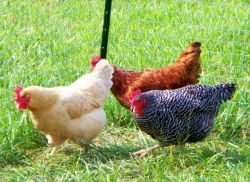
Everything You Need To Know To Raise Happy, Healthy Chickens
If anyone had told me that one day I'd have chickens for pets, I would have told them they were crazy! Little did I know that I would soon have 35 chickens, and names for all of them!
There is nothing more enjoyable than watching them wandering about the lawn, especially in summer. If you're lucky, they might jump in your lap so you can pet them!
Pet Chickens?
Would you consider having chickens for pets?
Why Should You Get Chickens?
There are a lot of reasons to keep chickens as pets. Those who are not familiar with chickens probably think you are keeping them just for the eggs. Here are some of the reasons you should keep chickens:
- They lay great tasting, nutritious eggs
- They are really friendly and have great personalities
- They will eat all of the pests in your yard (worms, bugs, etc), plus fertilize it to boot!
- They are natural "garbage disposals". Chickens can eat just about any leftover food
- Chickens are very low maintenance for the most part. Food, water & shelter, plus a little "play time" is all they need!
Pete, The Rooster
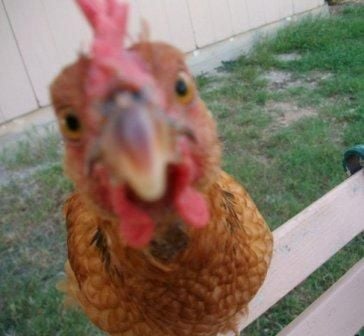
Pete is the son of Sally, my favorite hen, and Roho, my oldest rooster. From the time he was born, I carried him around as much as Sally would tolerate. Some afternoons, he & I would sit in the recliner and watch television. Pete is 6 years old now, and much too large & wiggly to sit in my lap! He does come running when he sees me, as he knows I always have a special treat for him.

Housing For Your Chickens
The first rule of business, before you get your new chickens, is to build them a place to live. In my case, I had never had chickens, much less knew anything about their housing or care. Luckily, my husband knew a thing or two about them, so he took on the building of the coop.
Chicken coops can be all shapes, sizes and designs. Some coops are just rustic wooden structures, while others are ornate houses. I've seen chickens living in children's playhouses, in metal sheds, and high up in barns. I doubt the chickens really care what their houses look like. They are more concerned about staying safe & out of the cold.
Regardless of what your coop looks like, there are some basic requirements to keep your chickens happy and healthy:
1) Walls: A coop needs to have at least 3 walls. The back one should face the north, in order to block the wind during the winter. The front, facing the south, can actually be chicken wire or hardware cloth (depending on your climate). While some people fear their chickens will freeze in the winter, they actually need fresh air!
2) Screening: Speaking of wire, you need to make certain all rodents, snakes and other predators cannot get to your chickens! Unless you get the small chicken wire (one inch openings or less), then hardware cloth is the way to go. Make certain the bottom of your coop is covered with this, in addition to all other openings.
3) Roof: It's best to have a solid roof, and even better to have one that slants. Metal sheeting is good, or you can even put on a shingle roof. I've done both, and they seem to work equally well.
4) Windows. It is not a requirement to have windows, but it can help to keep the breeze moving through the coop. It is important that your chickens have fresh air in order to prevent respiratory diseases. The windows are not glass. Instead, they are openings in the wall, covered with wire. One thing you can do is to have shutters over your windows, so you can close them in the winter.
5) Door. This may seem silly to mention, but it is really important. You can have a small door for your chickens to go in & out of. However, a "people size" door is really important! You don't want to find yourself on your hands & knees in chicken poop, trying to retrieve eggs or clean the coop.
5) Nesting Boxes. Chickens will lay eggs just about anywhere, but prefer small, dark places. You can make nesting boxes out of just about anything: cardboard boxes, plastic crates or tubs, or wood. For standard breed chickens, the nesting box should be about 12 inches wide and 12 inches deep. The nesting box should be up off the ground, but lower than the lowest roosting perch. You will need one nesting box to every 4-5 chickens.
6) Roosting Perches. Chickens like to sleep up off the ground, so put poles or branches inside their coop. The higher in the coop, the better. Make certain to allow enough room for each bird: about 5 inches per bird. If you put up more than one roost, they should be about 10 inches apart, with one a bit higher than the other.
7) Easy to Clean. This is extremely important! You need to clean the coop on a regular basis so your chickens don't get sick! Flies & other pests can be a big problem if the coop isn't clean!
If your chickens will be allowed to roam the yard, then this is all you need! However, if you wish to confine them to a certain area, you'll need to construct a "chicken run". This is an area that is fenced with either chicken wire or hardware cloth. You should bury the wire at least a foot under ground, so skunks, raccoons, rats & the like cannot dig under. If possible, it's best to secure the top of your run with netting to keep out hawks & other flying predators.
Chicken Coop Plans
You don't have to be an architect to build a chicken coop. However, it is helpful to have plans of some sort. If you'd rather have use some tried-and-true plans for a coop, check these out:


Layer Crumbles
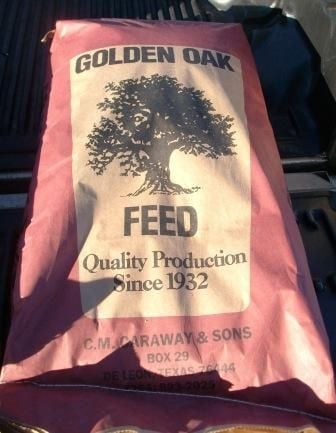
What To Feed Your Chickens
- Layer pellets or crumbles are complete feeds, meaning they contain exactly the right mix of vitamins, minerals, proteins, carbohydrates and fat. My chickens prefer the crumbles. You may have to try both with yours to see which they like. Chicken feed can be purchased at feed stores and online. Prices change fairly often, as they are dependent on the price of corn & other ingredients. Plan on around $13.00 for a 50 pound bag.
- Grit. Chickens don't have teeth, so they cannot break down their food before swallowing it. If your chickens don't have access to a yard that may have small rocks, then it's possible they will need grit. The grit is made up crushed rocks, which the chickens will store in their "crop". This is where they break down food before it enters their stomach. It is best to have a small container of grit near your chickens' layer feed, or you can mix a small amount in with their food.
- Oyster Shell / Calcium If you are feeding your chickens a quality layer feed,then you probably don't need this. However, it never hurts to have a small container of it next to their feed. It is inexpensive and lasts a long time. If you give your chickens too many treats and not enough layer feed, then they might not be getting enough calcium. You'll know if they are suffering a deficiency if their eggs seem weak or have irregularly shapes.
What Not To Feed Chickens
While you can feed chickens just about anything, there are a few foods to avoid:
* Orange, lemon, lime and other citrus fruits and peels, as they can cause a drop in egg production
* Bones of any kind
* Any large serving of meat, or meat that has gone bad. It is ok to feed them small or shredded pieces of meat. (Believe it or not, they will eat chicken if you feed it to them. That's just not right!)
* Garlic and onion. Although you may want to put crushed garlic in their water, if they are feeling under the weather
* Avocado skins and pits. The meat of the avocado is ok.
* Raw potato skins. Feel free to give them cooked potatoes. They really love them mashed!
* Long cut grass. Short, cut grass that you've bagged after mowing is great.
* Chocolate
Sally Teaches Pat How To Fly
Pat is another of Sally's babies. He is Pete's little brother. They were living in a cage in my shed, and I couldn't figure out how Pat was getting back in the cage at the end of the day. Here's what I learned:
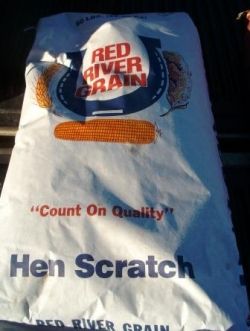
Chicken Snacks
Treats To Feed Your Chickens
Scratch - is mixture of grains including corn, wheat, oats and rye. This is not to feed every day, as it doesn't have all the nutrients they need. Just throw it on the floor of the coop, or out on the ground. You will know if you are feeding them too much of this as their eggshells will weaken and break really easily.
Buy a bag of this at your local feed store when you purchase their layer feed. A 50 pound bag runs around $11.00, depending on the price of grain.
Cabbage. A fun treat to hang from a tree branch or string in the coop. Place it where the chickens have to stand on tiptoe to reach it. Not only does it give them something fresh to eat, but also provides exercise.
My husband took a hay rake tooth, drilled a hole in one end, and hung it with a piece of wire from a tree branch. This has provided an immense amount of fun for both the chickens and us for the past several years.
Dehydrated meal worms may look a bit disgusting, but the birds really love them! Just toss a handful or two on the ground, and they will be gone in seconds!
Cabbage As A Chicken Treat
My chickens really love cabbage, so my husband attached a hay rake tooth to a wire, which in turn we hung from a tree branch. Great fun for all!
Dehydrated Mealworms
These are the brand of mealworms that I feed my chickens, ducks and guineas. They are especially good treats in the winter, when not many bugs are available. If you can't find them at your local feed store, this is a great way to purchase online!

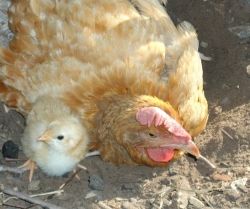
Bedding & Bathing
Bedding
Bedding is one of the most important parts of keeping your chickens happy and healthy. This is the stuff you put on your coop floor for the chickens to walk on. It will absorb the droppings and odor. It is also what you put in the nest boxes, to keep the freshly laid eggs a soft place to land so they don't crack.
You can put down just about any type of material. I am partial to hay, because it is readily available out here in the country. Many people use pine wood shavings, shredded leaves, or old newspapers. Do not use cedar shavings, as these are toxic to chickens! Keep in mind that you want something that is easy to clean up with a hayfork or shovel, because you need to change it fairly often.
The bedding material should be at least 2" thick. In the summer, it's best to have less, because you want to be able to see any snakes lurking around the nesting boxes!
Dust Baths
Chickens don't take baths like people, ducks or dogs. Although they will stand out in the rain, they prefer not to get wet. Instead, they love to take dust baths! The first time I saw a chicken take a dirt bath, I thought it was sick
Chickens will dig a shallow hole, loosen up all the dirt, and proceed to roll around in the dust to get as dirty as they possibly can. They do this because the dust helps prevent parasites (mites, lice, etc) from finding a home in your chickens' feathers and legs. When they are through with their baths, they'll hop up and shake the dirt out, just like a dog does with water.
If your chickens don't roam free, or if their run area doesn't have a place where they can dig a hole, you'll need to provide them with an artificial dust bath. Place a box or half-barrel on the floor of their coop and fill it with 6" of a "bath" powder. The bath powder should be made up of 1 part fireplace ashes, 1 part road dust, and 1 part sand. Some people also add 1 part diatomaceous earth.
Note: If you'd don't have access to all these ingredients, you can always just fill the box or barrel with topsoil. Just make certain it stays dry & loose!
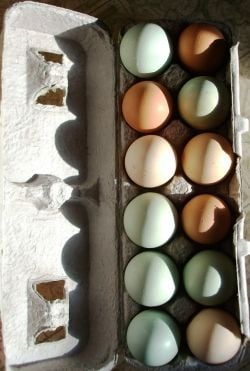
Fresh, Nutritious Eggs
One of the reasons you might want to raise chickens is for their eggs. You'll know they don't have any harmful chemicals, because you are the one feeding them! And you'll be surprised at the deep orange color of the yolks!
Eggs have all kinds of nutrients, including Vitamin D and Vitamin C, in addition to minerals and amino acids. The better you feed your chickens, the more nutritious they will be!
Eggs come in all sizes and colors, from white to browns and colors. White leghorns lay the traditional white eggs like you see in the grocery store. For brown eggs, try the "red" hens - Rhode Island, New Hampshire, and Production reds. For even more fun, raise a few Aracaunas or Ameracaunas. These are also known as the "Easter egg" chickens, because they lay eggs that are light blue or green. I have several of these hens. They are friendly, even tempered and their eggs are great!
A lot of people think you have to have a rooster in order to get eggs. Not true! While it is good to have a rooster, since they take care of their hens, it is not necessary for egg production. Only if you wish to have fertile eggs that your hens (or you) wish to hatch, do you need a rooster.
In order to produce an egg, a hen needs 12-14 hours of sunlight. In the summer, a hen might lay two eggs per day. In the winter, she might lay one every other day. If you want them to lay more in the winter, you'll need to add artificial light to their coop to simulate sunshine.
Friendliest Chicken Breeds
Many breeds of chickens are quite friendly, and love it when you spend time with them. I like to get a lawn chair & book, and sit in the yard with my chickens. They will fight over who gets to sit in my lap! Some will perch on the arms of the chairs, while Abby, my Buff Orpington, likes to snuggle up on my side. I even have several that like to ride around on my shoulder!
I've found that the friendliest breeds are the Buff Orpington, the Black Australorp, the Partridge Rock, and the Aracauna. Several of my production reds are friendly, but not all. The best thing to do is get them while they are chicks, and handle them a lot. You will be surprised how much it makes a difference!
I received my first 5 hens & 1 rooster in early 2007 as a gift from my neighbors. Since then, I've bought some by mail order, others at the local feed store, incubated eggs, and let hens hatch their own. As I sit here this morning, watching my chickens roam the yard, I'm planning on which breeds I'm going to get next. Because... I'm addicted to chickens... and there's always room for more!
More Chicken-Related Articles
- The Headless Chicken Festival of Fruita, Colorado
In 1945, in a small town in Colorado, a farmer cut off the head of Mike, his rooster. Mike went on to become famous, and a celebration in his honor is held each May - The Chicken Health Handbook
The ultimate book for chicken lovers: everything you need to raise and take care of chickens.
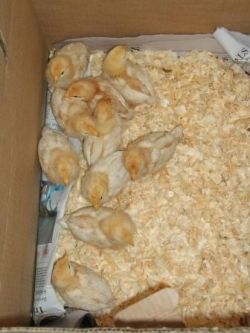
Yes, I'm addicted to chickens!
Latest family members - March 2013
I went to the store today to purchase a new swimming pool for my ducks. While there, I took a look at the new chicks that had just arrived. I told the sales clerk they were cute, but that I didn't need any.
He let me know there were another group of chicks near the front door that were older than these newborns. It turns out they were put on sale, because no one wants the older ones.
I don't need any chickens. I already have plenty to feed! But, I just can't resist babies; especially those that no one else wants!
As I later told my step-son: "I went to the store to buy a swimming pool. I came home with chicks, but no pool. Don't send me to the feed store to buy you anything, because there's no telling what I'll bring home!"
Two months old - in the willow tree




